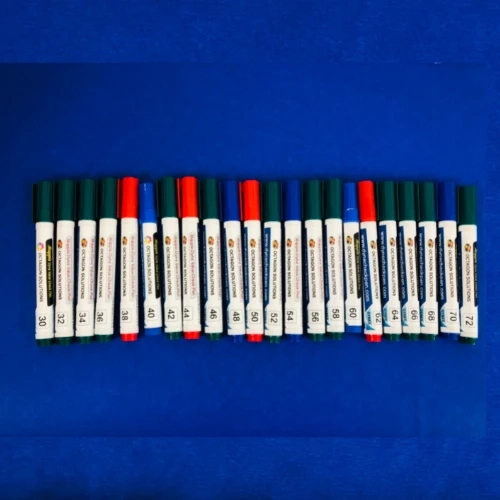This leaflet describes how the Dynes Test Pen can be used to measure the surface energy of films and other non-absorbent substrates. This method is parallel to ASTM Std. D2578¹, which covers the testing of polyethylene (PE) and polypropylene (PP) films through the application of formamide/ethyl cellosolve* solutions. The fluids used in DYNE Test Pens are based on the fluids specified in ASTM D2578; The main difference between this test and the ASTM technique is the way the liquid is applied to the test specimen.
In general, the ability of inks, coatings, or adhesives to adhere to a substrate is directly related to its surface energy. If the substrate surface energy does not exceed the surface tension of the fluid it is to cover, wetting will be inhibited and a poor bond will result. Clearly, the surface energy must be assessed before printing, coating, or laminating is attempted.
The unit of measurement of surface energy is dyne pens. It can also be expressed in mN/m. dyne = unit of force, equal to the force that accelerates a mass of 1 gram by 1cm/sec/sec. 1 dyne = 0.00001 newton
Typical Surface Energy of Base Material
Required Surface Energy for Adhesion with:
PTFE <20 mN/m(Dyne)
UV Ink 48 – 56 mN/m(Dyne)
Silicone <20 mN/m(Dyne)
Waterbased Ink 50 – 56 mN/m(Dyne)
PP 30 mN/m(Dyne)
Coatings 46 – 52 mN/m(Dyne)
PE 32 mN/m(Dyne)
UV Adhesive 44 – 50 mN/m(Dyne)
PS 34 mN/m(Dyne)
Waterbased Adhesive 48 – 56 mN/m(Dyne)
PC 34 mN/m(Dyne)
ABS 34 mN/m(Dyne)
DYNE Test pens perform well on most non-absorbent materials. It is important that the test fluid does not change the surface properties of the substrate. For example, if the test fluid penetrates a fiber substrate (such as paper) and causes swelling, the results will indicate unrealistically easy wetting. A chemical reaction between the test fluid and the substrate will completely invalidate the results.
To ensure the repeatability of this test, material preparation and testing techniques must be standardized. ASTM Std. The D618² documents suggested conditioning methods. Unfortunately, this standard-treated film is unstable for testing; The conditioning time ranges from 24 to 96 hours. Such stringent controls may be important for R&D, but much shorter conditioning times should be used for general QC testing. Standardization of ambient, substrate, and test solution temperatures is important, as is the inspection method. Have an instructor instruct all testers to reduce variability. relative humidity should not be excessive; Higher RH increases data variability. Finally, the elapsed time between tests for extrusion or coating (or tests for printing, etc.) must be controlled.
Surface energy is critically important for many conversion operations. Unfortunately, it is not the sole determinant of product suitability. Other factors such as surface topography, coating rheology, and chemical incompatibilities must also be considered. That's why broad-based communication with vendors and customers is so important. But at least by systematically measuring the substrate surface energy, you'll have a sound starting point from which to solve other problems that may arise.
It is a relatively accurate surface energy measurement technique; Used in standard 2 dyne/cm increments, DYNE Test pens can typically give results with an accuracy of ± 2.0 dyne/cm. Repeated use of the dyne test pen should enable testers to estimate surface energy to within ±1.0 dyne/cm.
To investigate discrepancies between the obtained and expected results, a more accurate measurement method should be considered; the Use of DYNE Technology Surface Tension Test Ink or drawdown rod is recommended. Alternatively, if the results are questionable, repeat the test with a set of unused pens. it is tested
and proven itself on a wide variety of substrates; however, it is theoretically more prone to contamination than some other techniques. For this reason, even in the absence of unexpected results, you should establish a quality assurance plan that requires regular audits during the step-by-step use of the dyne Test Pen. effect of all changes
Transitions from one substrate to another should be monitored especially closely. Slips and other additives bloom on the surface of extruded sheets and films; The transfer of surface-active additives from one material to another can have a profound effect on surface energy measurements. In general, once you demonstrate that the substrate switches from A
Substrate B has no effect, it is relatively safe to assume that a future change from A to B will act similarly.
Surface energy is critically important for many conversion operations. Unfortunately, this is not the only determining factor in product suitability. Other factors such as surface topography, coating rheology, chemical incompatibilities, etc. must also be considered. Properly stored and used Dyne Test Pens will give you a good indication of surface energy on many materials, however, you should always verify your results by sample manufacture.
0


